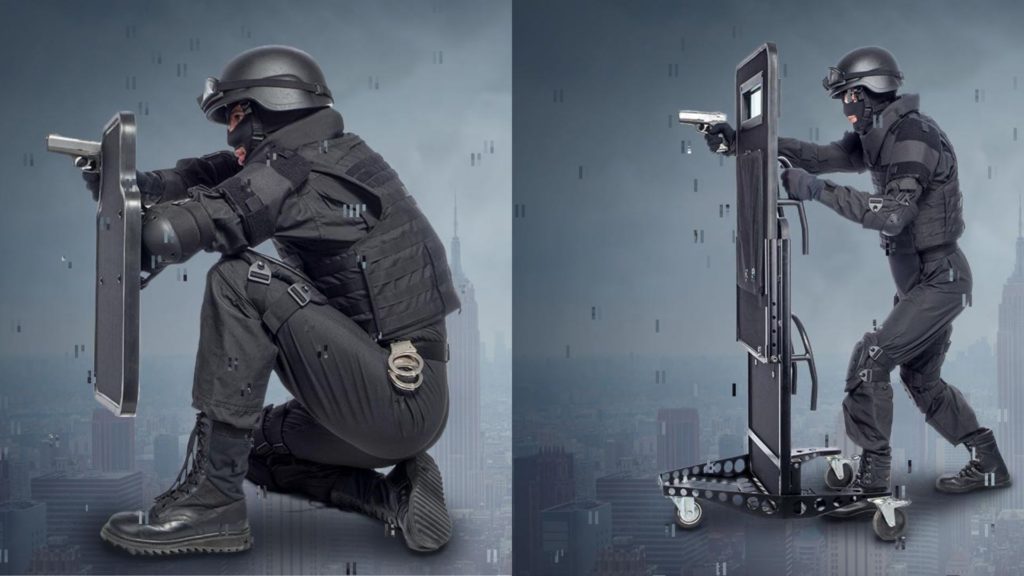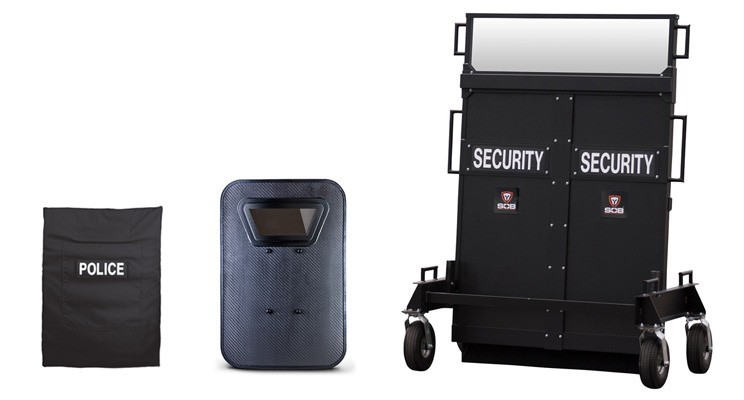Shop by Industry
Industries we support...
Products
START SHOPPING...
EXPLORE by category
Product Series
Resources
Contact
Find a Dealer
In the early 2000s, many shields on the market were rectangular with flat fronts (and sometimes with curved edges). This simple, straightforward design stopped select bullets and saved lives. While effective, they were heavy, which made them challenging to hold for extended periods of time. As a result, operator speed and mobility slowed significantly, especially when the situation required the user to cover a lot of ground.
In the past, some departments chose not to use ballistic shields because of this reason. Advancements in materials, however, (including the use of composites, hybrid composites, carbon fiber, Kevlar and ceramic) have significantly reduced shield weight.
In some cases, Level III shields went from 50 lbs (23 kg) to 14 lbs (6 kg) in 10 years. This allows the officer to move around much faster in dynamic threat scenarios while still maintaining the same level of ballistic protection. Essentially, departments can purchase soft armor Level IIIA shields that perform just as well as hard armor Level IIIA shields from 20 years ago with better maneuverability due to their weight and design.

Ballistic shields are available in a variety of sizes and shapes to best protect against specific threats. Depending on the manufacturer, shields can come in a variety of sizes. Some ballistic shields are as small as 16 x 20 inches (41 x 53 cm) for use when there is additional ballistic protection (trees, walls, etc.) nearby. These are designed to protect the torso (vital organs), face and neck while being easy and fast to deploy. They make a lot of sense for patrol officers to have in their car for establishing and maintaining perimeters or entering questionable scenes.
Certain shields are significantly larger at 24 x 48 inches (61 x 122 cm) to offer full body protection. The most common shield sizes tend to be between 20 x 30 inches (51 x 76 cm) and 24 x 36 inches (61 x 91 cm). These offer a combination of protection and mobility. Finally, there are large Level IV rolling shield systems that bring maximum ballistic protection. These provide overhead protection and can protect multiple officers at the same time. The tradeoff here is increased protection for increased weight along with decreased mobility and speed.
Each unique shape, each unique shape has its own inherent advantages and limitations.

All ballistic shields are designed to stop or deflect bullets fired at their carrier. The materials used impact the weight and protection.

Viewports are the clear windows in shields that allow the operator to see. Like the rest of the shield, the viewport needs to be ultra-durable and bullet resistant. For this reason, viewports are made of stronger materials like polycarbonate.
Technological advancements have resulted in different sized and shaped viewports. In some cases, a small viewport is sufficient to get the job done. Some of the newer shields have viewports that are wider and taller so that the operator can see straight ahead, laterally and up and down. This added visibility increases the officer’s safety and provides them with the tactical advantage of having eyes on the threat at all times.
Not all ballistic shields have a viewport. In some cases, the viewport can be the heaviest part of the shield. In addition, any scratches or damage to the viewport will limit vision.
Up until recently, most ballistic shields were only available in black so as not to draw much attention. Recently, additional colors have become available in select shields including Tan, Coyote, Ranger Green, Multi Cam and Multi Cam Black. Some shields have Kevlar-looking finishes. Some shields are painted so as to refract NIR (near infrared), which prevents some night vision goggles (NVGs) from being able to see the shield (and user behind it).
Some manufacturers introduced transparent ballistic shields made of polycarbonate laminate. These include the Blue Ridge Armor Clear-Guard , Safariland Hi-VIZ Type IIIA Shield and METT-T LLC TAC Shield that offer Level IIIA protection. Their transparent design minimizes visual obstructions and helps the officer better see trip hazards and identify threats.
Handle systems determine how a shield is carried. This critical design feature therefore impacts the firearms and shooting styles used. Departments have different carrying carrying methods and some unique handle designs can accommodate multiple preferences.
The best handle design will vary based on each agency's SOP (standard operating procedure) for training and shield carrying method. Many of the handle systems have a solid 2 position or 3 position carry method that allows for single and dual handed operation. An ambidextrous handle design allows right and left handed operators to carry a shield without having to make adjustments on the handle. Ergonomic additions like high density forearm pads add comfort when carrying the shield and reduce backface injuries to the forearm.
Different handle options are available:
Handles used to be simple plastic or metal attachments. Nowadays, these handles are made of aluminum, polycarbonate or composite materials. In some cases, handles are even integrated into components like lighting systems for a more streamlined design.
Like anything else, sometimes handles break and need to be replaced. Select manufacturers offer replacement handles. Consult the manufacturer recommendations and warranty before purchasing or installing a unique handle system to an existing shield.
Thanks so much to Tracey Willmott, Mario Cugini, Phillip Spencer, Mark Cardey (The Safariland Group), Paul Banducci (United Shield International), Mike Ott (Point Blank Enterprises), Chris Sfedu (EDI-USA) and HighCom Armor for their assistance with this article.



Enter your details below to save your shopping cart for later.